
Bohemian Ruby Glass Punch Bowl Set with Undertray, circa 1900
A Bohemian ruby and clear glass lidded punch bowl and Undertray, circa 1900, the punch lidded bowl of faceted barrel form, with arches design between bands of slice cuts, with domed cover and faceted finial, raised on a petal form Undertray. Height 33 cm,…

Ornate Bohemian Wine Glass from Early 20th Century
Early 20th century Bohemian wine glass with ornately etched decoration, 15 cm high

Bohemian Ruby Glass Punch Bowl Set with Undertray, circa 1900
A Bohemian ruby and clear glass lidded punch bowl and Undertray, circa 1900 the punch lidded bowl of faceted barrel form, with arches design between bands of slice cuts, with domed cover and faceted finial, raised on a petal form Undertray. Height 33 cm,…

Rikaro Bohemian Glass Flamingo: Handmade Art Glass, 21.5cm High
Rikaro Bohemian glass flamingo, with original foil label 'Rikaro hand made Art Glass', 21.5 cm high

Scandinavian Glass Collection: Holmegaard, Ricaro, Strombergshttan (3 items)
Holmegaard Danish glass bowl, Ricaro Bohemian blue glass console bowl, Strombergshttan Finnish blue glass ashtray, (3 items), the largest 34 cm wide.
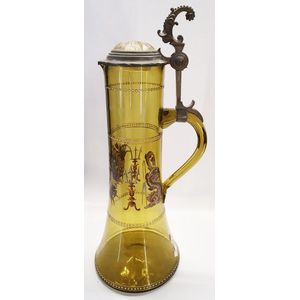
19th Century Bohemian Enamelled Glass Flag on with Poseidon Portrait
A 19th century Bohemian enamelled glass Flagon, the tapering cylindrical body enamelled with a portrait of Poseidon, with dolphins and tridents, pewter mounts and scrolling thumbpiece, height 46 cm.
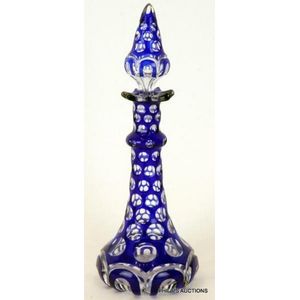
Bohemian Blue Flash Glass Scent Flask with Original Stopper
A Bohemian blue flash glass scent flask and stopper, late 19th century, the scent flask of tapering form in cobalt and clear glass, cut with graduated bands of lenses above a gadrooned lower section, with original stopper. Height 21 cm

Blue Bohemian Glass Pedestal Bowl, Early 20th Century, Decorated
A Bohemian blue overlay glass pedestal bowl, early 20th century, the ogee form pedestal bowl with repeat petal rim raised on an inverted baluster pedestal to a broad domed foot, decorated all over with graduated bands of flat lens Cuts. Height 20 cm,…

Bohemian Ruby Glass Pedestal Bowl with White Overlay, 19th Century
A Bohemian white overlay ruby glass pedestal bowl, 19th century, the circular form pedestal bowl with repeat ogival rim and arched panels, alternately diamond cut and gilded with leaves and raised on an inverted baluster faceted pedestal to a conical…

1920s Bohemian Art Deco Glass Perfume Bottle with Floral Decoration
A Bohemian Art Deco glass perfume bottle with pressed floral decoration, circa 1920s, 15 cm high

Bohemian Art Deco Frosted Glass Figural Dish
An Art Deco Bohemian frosted glass figural dish, circa 1930, 9 cm high, 13.5 cm wide
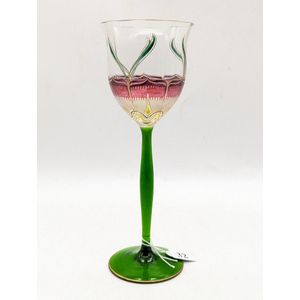
Art Nouveau Enamelled Wine Glass with Bristol Green Stem
Fritz Heckert wine glass, Art Nouveau Bohemian stemmed glass enamelled abstract decoration to bowl with Bristol green stem, height 21.4 cm

Enamelled Lilac Stemmed Glass with Floral Design
Fritz Heckert stemmed glass, Art Nouveau Bohemian enamelled lilac form floral glass, stem graduating from clear to green, height 15.8

Bohemian Enamel Floral Stemmed Glass
Fritz Heckert stemmed glass, Bohemian Art Nouveau enamel floral form glass on graduating green stem, height 16.3 cm
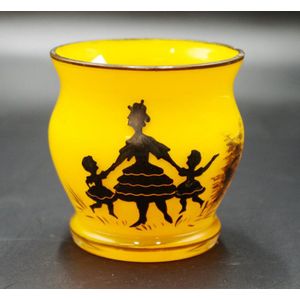
Bohemian Silhouette Glass Bowl
Art Deco Bohemian yellow glass bowl decorated figures in silhouette, diameter 7 cm.
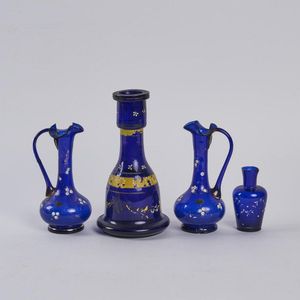
Bohemian Painted Glass Collection
A collection of Bohemian glass items, all with painted decoration, some wear. Tallest. Height 27.5 cm, diameter 14.5 cm
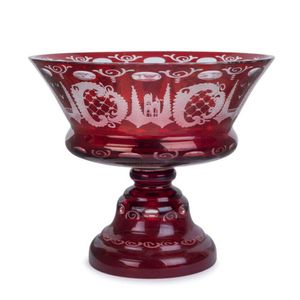
19th Century Bohemian Ruby Glass Compote with Wheel Cut Decoration
Bohemian ruby glass compote with wheel cut decoration, 19th century, 18 cm high, 20 cm diameter

Bohemian Pink Glass Fish Bowl with Flower Arranger
Good Joseph Inwald Bohemian glass float bowl pink glass float bowl, diameter 30 cm, with fitted glass flower arranger, surmounted by a fish figure.

Bohemian Ruby Epergne with Gilt Brass Base
Antique Bohemian ruby flashed and painted highlight epergne centre piece gilt brass, scrolling floral base, 45 cm high

Ingrid Ao' Bohemian Glass Classical Woman Sculpture
A Bohemian glass sculpture of a stylised classical woman, signed Ingrid Ao' to base, height 21 cm. Provenance: Estate of Anton Minge

Bohemian Floral Cased Glass Box with Facetted Finial
19th century Bohemian cased glass box and cover, of bun form the cover with facetted finial, decorated with floral sprays and c-scroll, height 15 cm and diameter 18 cm

Assorted Stemmed Glassware Collection
A miscellaneous collection of stemmed glass table and drinking ware, including Stuart, the Bohemia style bowl 20 cm diameter
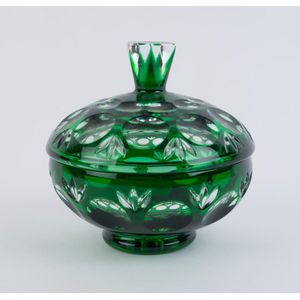
Green Glass Bohemian Lidded Bowl - 20th Century
A Bohemian green overlay glass lidded bowl, 20th century, 14 cm high, 14 cm wide

Bohemia Glass Lantern with Gilt and Enamel Decoration
19th century lantern, Bohemia glass with extensive gilt and enameled decoration, frosted and cut glass shade, converted to electricity

Bohemian Glass Triple Distillery Bottle, 1920s
A Bohemian glass triple distillery bottle, circa 1920s, acid etched circular mark Czechoslovakia, 57 cm high

Barolac Mermaid Pink Glass Fruit Bowl
A Bohemian Art Deco pink glass fruit bowl with mermaids and lotus flowers by Josef Inwald Barolac, circa 1930, 15 cm high, 31.5 cm diameter

Bohemian Glass Baskets, Late 19th-20th Century
Two Bohemian glass baskets, late 19th and early 20th century, 15 cm and 13 cm high

Speckled Art Glass Fruit Bowl, Late 19th Century
Continental heavy art glass fruit bowl, unusual speckled design cased in tinted clear glass with crackle finish interior, pontil mark not ground, base displaying lots of wear, possibly Italian or Bohemian, late 19th early 20th century, 13 cm high,
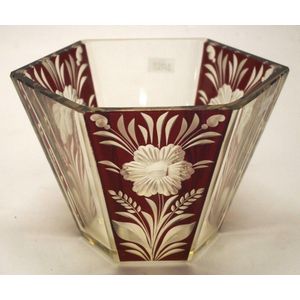
Floral Bohemian Red Cut Glass Bowl - 12.5cm Height
Bohemian red flash cut glass bowl with floral decoration, height 12.5 cm

Art Deco Bohemian Glass Fish Pair, 1930
A pair of Art Deco Bohemian moulded glass fish, circa 1930, bearing the factory mark 'Tchecoslovaquie' underneath, 15.5 cm high

Glass Collection: Animals, Ornaments, and Paperweights
Murano glass triangular dish, Bohemian crystal bowl, 3 Bimini glass animals, Mats Jonasson glass paperweight, Wedgwood crystal snail, crystal cat ornament and an English glass paperweight, 20th century, Murano dish 26 cm across

Art Deco Czech Glass Elephant Statue
A Bohemian Art Deco glass elephant statue, circa 1920, stamped 'Made in Czechoslovakia', 18 cm high

Blue Bohemian Cut Glass Dish and Bowl Set
A Bohemian dish and bowl, blue glass cut to clear. Diameter 18 cm and 26 cm.

Mid-century Bohemia Glass Tray, Deep Red, 29cm Diameter
Bohemia glass tray mid 20th century deep red colour Diameter 29 cm

Bohemian Glass Jar with German Farming Scenes
A 19th century Bohemian lidded glass jar, decorated with panels of German farming scenes and various animals, decorative cutting to base, rim and lid. Some small chips. 13 cm x 30 cm. Provenance: The Flower Family Collection.

Hand-painted Ruby Red Glass Jug with Stopper
Bohemian ruby red glass and enamel hand painted small jug with stopper

Baroque Ruby Glass Ewer with Gilt Decoration
Large Bohemian ruby glass ewer. Faceted body and stopper, with gilt Baroque decoration. Height 34 cm

Bohemian Cranberry Glass Thistle Goblet
Late 19th century Bohemian cranberry glass, of thistle form, in gilt, with cut scalloped pattern to foot, height 13 cm

Bohemian Gilt Finger Bowl in Opaque Glass Bucket
Late 19th century Bohemian glass finger bowl, in the form of a bucket, in opaque glass, accented in gilt, diameter 12 cm

Floral Cut Glass Jar with Purple Flashing
Bohemian purple flashed glass jar and cover, with a knop finial above bands of cut floral motifs, above baluster body on circular foot, a/f, height 20 cm

Bohemian Oil Spot Glass Bowl
A Bohemian green glass 'Oil spot' bowl, early 20th century, a low conical bowl with a dimpled body and a waisted gathered style rim, with iridescent oil spots in pink, gold and aqua colours, with a polished pontil, height 10.5 cm, diameter 20.5 cm

Bohemian Enamel Overlay Glass Vase
19th century Bohemian glass with hand painted enamel overlay, lemon squeeze base, approx 16 cm high

Bohemian Green Glass Ruffled Bowl
A hand painted Bohemian green glass stemmed bowl with Ruffled edge, diameter 31 cm, height 21 cm

Bohemian Ruby Glass Overlay Shade, 19th Century
Bohemian 19th century overlay shade, painted on ruby glass, approx 22 cm high, 31 cm diameter

Bohemian Pedestal Wine Glass with Foliate Design
19th century bohemian pedestal form wine glass, etched and hand painted foliate design, and guilding to edge, approx 11 cm high

Bohemian Ruby Glass with Etched Cornucopia and Triumphal Horn
19th century bohemian hexagonal form ruby glass, etching of cornucopia, triumphal horn etc, olurk approx 11 cm high

Bohemian Glass with Porcelain Flower and Gold Gilt
Bohemian glass with porcelain flower over windows, gold gilt on glass 19th century Retaining retailer label to base, approx 11 cm high
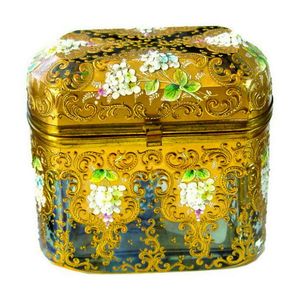
Bohemian Glass Casket Box with Floral Gilt Decoration
A fancy c.1900 Bohemian glass casket box, rounded rectangular form, blue tint, highlighted with fine sculpted floral bouquets on elaborate gilt decoration ground, gilt metal mounts. 11 x 7 x 10 cm

Bohemian Glass Pedestal Dish, 1950
A Bohemian glass dish raised on pedestal. C.1950. Height 6 cm diameter 14 cm

Bohemian Cut Glass Obelisk, Circa 1900
An unusual Bohemian cut glass and coloured glass obelisk, Circa 1900. 27 cm high

Red Bohemian Glass Bon Bon Dishes with Floral Gilt Decoration
Two red Bohemian glass lidded bon bon dishes decorated with gilt and floral decoration, height 23 cm approx (tallest)

Bohemia Amber & White Glass Cologne - Unique Design
An unusual Bohemia amber and white cased glass cologne 15 cm high

Bohemia Ruby Glass Bowl with Floral and Bird Decor
An exceptional quality mid-nineteenth century Bohemia ruby-cased glass lidded bowl hand-decorated with floral bouquets and songbirds.

Gilded Bohemian Cobalt Glass Jug with Porcelain Flowers
An ornate gilded cobalt glass jug in the Bohemian style, 20th century, the tall tapering jug with a looped handle richly gilded with shaped reserves, scrolls, beadwork and lattice in gilt paste, and encrusted to both sides with painted porcelain bunches…

Bohemian Satin Glass Trinket Box with Shepherdess and Flowers
A Bohemian satin glass trinket box, later 19th century. of globular form and hinged with a low dome lid, decorated with a shepherdess surrounded with flowers and gilt paste to a lemon ground; the lower body also with a frieze of flowers. Height 8.5 cm.…

Victorian Ruby Glass Bell-Shaped Toilet Bottle
A Victorian Bohemian glass toilet water bottle, in the form of a bell, with ruby glass, gilding and white enamel decoration. Height 20 cm

Red Bohemian Glass Candlesticks, 21 cm Tall - Pair
Pair cut red bohemian glass candlesticks, 21 cm tall

Bohemian Red Glass Bowl and Candlesticks Set
A Bohemian red overlay glass bowl together with pair of candlesticks. Diameter of bowl: 24 cm.

Bohemian Ruby Glass Bowl with Gilt Highlights
Antique Bohemian ruby glass bowl with gilt highlights, 16 cm wide approx.

Bohemian Amber Pedestal Bowl - 17cm Diameter
A 19th century bohemian amber tinted pedestal glass bowl. Diameter 17 cm

Bohemian Blue Glass Dish with Gilt Highlights
A 19th century Bohemian blue glass dish, heightened in gilt. Diameter 25 cm.

Intaglio Cut Ruby and Clear Glass Stag Jug
A Bohemian ruby and clear glass jug intaglio cut with a stag in a forest glade. Height 13 cm

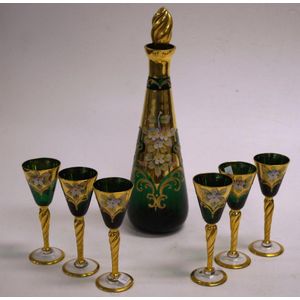

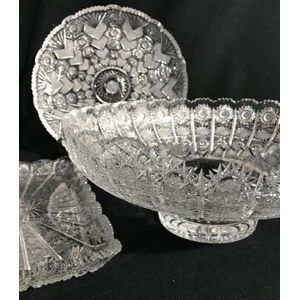
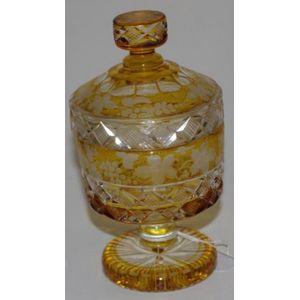


 Loading more...
Loading more...